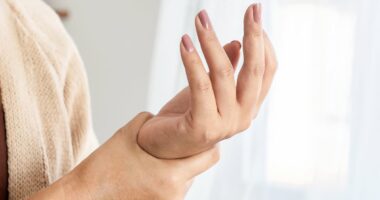Share this @internewscast.com
A top GP has warned that crusty heels—often dismissed as nothing more than dry skin—could actually be a sign of a ‘highly contagious’ fungal infection which, if left untreated, can even become life-threatening.
The common condition, athlete’s foot, affects nearly one in six people in the UK.
‘Yet many people are unaware they have it. It can easily be dismissed as just a patch of dry skin,’ Dr Deborah Lee, a GP at Dr Fox Online Pharmacy, told us.
While athlete’s foot usually starts between the toes, she explained that it can spread across the soles and heels. ‘Typically, it causes redness, scaling and soreness between the fourth and fifth toes,’ she said.
The affected skin may look ‘macerated, boggy, ulcerated and peeling’, but Dr Lee added that ‘it can also cause redness, dryness and scaling on the edge of the feet.’
‘This can develop into painful fissures and rarely, blisters can occur on the soles of the feet,’ she said.
‘Although it is often itchy and sore, it’s perfectly possible to have athlete’s foot with no symptoms at all.’
Dr Lee stressed it is important to catch the infection early, warning that if it spreads unchecked it can lead to serious complications that in rare cases prove fatal.


Dr Deborah Lee, a GP, warned the condition if left untreated can lead to serious complications

It is caused by Trichophyton rubrum, also known as tinea pedis, that is microscopic to the eye
‘If you don’t control athlete’s foot early on, it can quickly spread. The fungus damages the barrier protective effect of the skin allowing infecting organisms into the skin,’ she said.
And she continued: ‘If left untreated, this can result in secondary bacterial infection, impetigo or cellulitis’. The latter of which ‘can cause sepsis, which is life-threatening’.
It can also start to affect the toenails, resulting in ‘discoloured crumbling toenails’ that can be painful and in serious cases ‘severely reduce quality of life,’ she warned.
If you notice signs, you should go to a doctor right away, who she said can usually diagnose it by looking at it, but scrapings can be tested to confirm it.
It is more common in those with weakened immune systems like the elderly, those with diabetes, on cancer treatments, taking immunosuppressants, on steroids, or with an underactive thyroid.
It is caused by Trichophyton rubrum, also known as tinea pedis, which is microscopic to the eye but ‘looks like worms’ under a microscope, she said, but no worms are actually involved.
Her warning comes amid soaring temperatures, which she said makes matters worse, as the fungus ‘thrives in the heat, especially hot, sweaty shoes and trainers,’ but also sandals because their feet ‘dry out in the hot sun and lose their protective oils.’
And if you’re thinking of cooling off in a swimming pool, this is probably the worst place you can be, because, she said: ‘It takes just one infected person to spread tinea organisms all over the swimming pool area.’

The fungus, she warned, is particularly a problem if you’re trying to cool off at a swimming pool
Dr Lee had several helpful tips to lower the risk of developing the painful skin condition during hot weather.
She said: ‘Wash feet once a day with soap and water and dry them carefully, including between the toes.’
Because the troublesome fungus can spread through shared bedding, clothing, and towels, she said it is best to use a separate towel at home or the pool.
She also recommends shoes that are ‘made of a breathable fabric such as canvas or leather’. This is because ‘all synthetics retain heat and encourage the feet to heat to heat up and sweat’.
For the same reason, she advised wearing socks with natural fibres such as cotton or wool, as many people may not realise lots of socks can be made from polyester.
It can also help to switch footwear ‘every two or three days,’ she said, and it is best to avoid secondhand shoes or socks.
When attending a public swimming pool or changing rooms, she said: ‘Cover feet by wearing flip flops.’
To ensure the condition is caught early on, she added: ‘Check feet regularly for signs of redness, scaling or blisters.’
If signs appear, she urged covering any wounds, seeking pharmacist treatment immediately, and monitoring healing.
‘Terbinafine is an antifungal cream, spray or powder that can be used first-line. Alternatively, you could try clotrimazole, miconazole or econazole cream,’ she said.
She added that directions for use should be followed carefully, and a GP appointment booked if symptoms are not improving.
A GP should be consulted urgently, she warned, if the leg is red, hot and swollen, there is severe pain, or the rash has spread to other parts of the body.
It is also important to seek medical advice promptly in those with diabetes or a weakened immune system.













